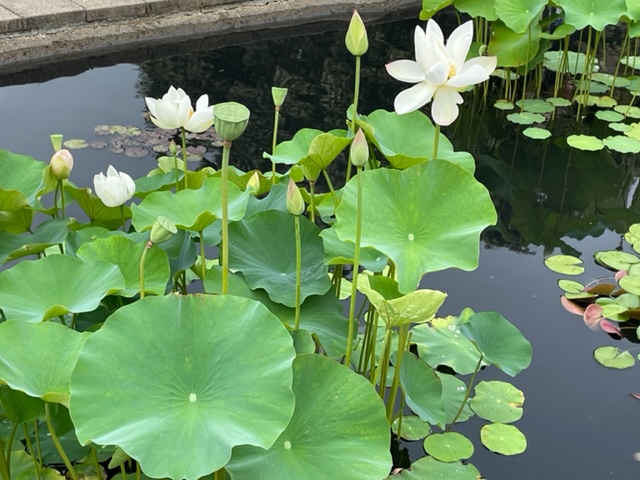
A recent visit to the Atlanta Botanical Gardens found me in open – mouthed wonder in front of a pond where both water lilies and lotus were in full and brilliant bloom. It was great to see them growing side by side because though they share many of the same characteristics, there are also many distinctive differences between these two bathing beauties.

The American water lily Nymphaea odorata has leaves that float directly on the water. In the wild, the rhizomes can root in up to 8 feet of water in a pond or small lake. The abundance – and potential trouble – of this species varies with location. Though considered an invasive weed in California and Washington state, it is considered threatened in Connecticut. Don’t confuse our native water lily with many other harmful and invasive water plants that clog small bodies of water.
The American water lily was considered an important food source by native Americans. All parts are edible – seeds, flowers, buds and rhizomes. The seeds were roasted and eaten like popcorn.

The leaves of giant water lilies of South America are so strong that they can support the weight of a small child.

Perhaps even more beautiful is the lotus. Differing from the water lily, the leaves and flowers of lotus are held above the water surface from 6 inches to 3 feet tall. Worldwide, there are only two species of lotus, the American lotus and the sacred lotus of Asia.

Both species produce seeds that are amazingly long lived. Seeds of American lotus have stayed viable for over 200 years – but seeds of the Asian species have germinated after a thousand years. The “lotus” effect was discovered by scientists who studied the remarkable capacity of the lotus leaf to shed water. When water hits the surface of the leaf, it immediately clumps into droplets, taking with it any available dirt or mud. The droplets roll off, leaving the surface clean and dry.

Scientists in Australia found that the Asian lotus plants maintained an even temperature between 86 and 95 degrees, even when outside temperatures dropped into the low 50s.

Because the beautiful, pristine blossoms of lotus grow out of the mud and muck of a pond, the lotus has come to symbolize purity, transformation and enlightenment.
